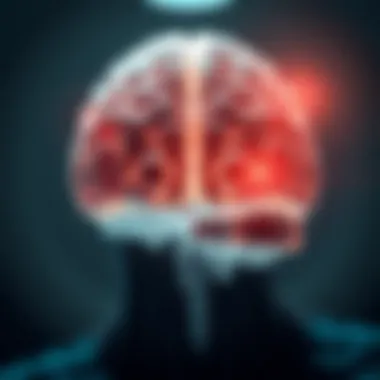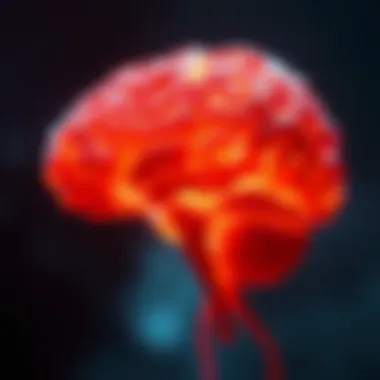Survival Rates of Level Three Brain Tumors Explained


Intro
Level three brain tumors, known scientifically as anaplastic tumors, present a significant challenge within the realm of oncology. These tumors vary widely in their behavior, prognosis, and treatment responses. While it’s easy to get lost in the medical jargon surrounding these conditions, understanding the survival rates associated with them is crucial. Not only does it shape treatment approaches, but it also offers important insights to patients, caregivers, and healthcare professionals.
Survival rates indicate the percentage of people who are alive for a specific period after being diagnosed with a certain type of cancer. In the case of level three brain tumors, these figures can fluctuate based on various factors. Demographics such as age, gender, and overall health often play considerable roles. Furthermore, the type of treatment received and advancements in medical technology can also sway these survival projections.
In this exploration, we will dissect critical aspects relatable to survival rates, combining statistical data with professional literature reviews. This guide aims to equip readers with a comprehensive understanding of what living with and surviving these tumors entails. Whether you're a student delving into oncology or a caregiver seeking clarity, the nuances addressed here aspire to be informative and illuminating.
Understanding Brain Tumors
Understanding brain tumors is critical, not only for medical professionals but also for patients and families who navigate this complex landscape. Each brain tumor presents unique challenges and necessitates tailored approaches to treatment and care. Knowledge about brain tumors can empower individuals, helping them make informed decisions and fostering a sense of control amid uncertain circumstances.
When discussing brain tumors, it's essential to grasp the terms and classifications that define their nature, as these factors frequently determine the course of treatment and prognosis. Brain tumors vary widely in terms of their origin, cellular composition, and aggression. Thus, a solid grasp of tumor characteristics is vital in assessing survival rates and exploring effective intervention strategies.
Furthermore, understanding the differences among tumor types—particularly malignant versus benign—is foundational in comprehending why certain tumors behave distinctly, respond differently to therapies, and impact the patient's quality of life.
Moreover, recognizing the latest advancements in research, treatments, and technologies is vital. This information can significantly shape survival outcomes, as emerging therapies may extend lifespans or even contribute to long-term remission for some patients.
In summary, a well-rounded understanding of brain tumors equips individuals with knowledge that’s crucial. With this knowledge, patients can engage actively in dialogues with their healthcare providers and navigate their treatment pathways more effectively.
Classification of Brain Tumors
Brain tumors are classified based on various factors including their location, type of cells involved, and histological grade. The main classifications include:
- Primary tumors: Arise from brain tissue or nearby structures.
- Secondary tumors: Metastatic tumors that originate from cancers elsewhere in the body.
When discussing primary tumors, each type, such as astrocytomas or meningiomas, carries its own set of characteristics and implications for treatment. Within primary tumors, the classification extends into grades ranging from I (least aggressive) to IV (most aggressive), informing both prognosis and treatment approaches.
Differences Between Malignant and Benign Tumors
Malignant and benign tumors differ markedly, impacting survival rates and treatment decisions. Malignant tumors are cancerous, characterized by uncontrolled cell growth, potential invation into surrounding tissues, and the capacity to metastasize to other parts of the body. In contrast, benign tumors grow slowly, are generally well-defined, and usually do not spread to surrounding tissues.
Recognizing these differences is crucial:
- Malignant Tumors:
- Benign Tumors:
- Present significant risks, leading to various neurological deficits, depending on the tumor's location.
- May require aggressive treatment approaches such as surgery, chemotherapy, and radiation therapy.
- Prognosis is often poorer due to their invasive nature.
- Typically have a better prognosis and can be managed with less aggressive treatments.
- Often curable, especially when detected early and surgically removed.
"Understanding the type of tumor is pivotal in crafting an effective treatment plan and can dramatically impact outcomes."
Awareness of these differences shapes patient discussions and decisions about therapy, ultimately affecting the survival trajectory in brain tumor management.
Defining Level Three Brain Tumors
Defining level three brain tumors is critical for understanding not only how they affect individuals but also the context in which treatment options and survival rates are evaluated. Grade three tumors, classified primarily by the World Health Organization, indicate an increasing aggressiveness in tumor behavior. Unlike lower grades, these tumors are often malignant, rapidly growing, and may infiltrate surrounding brain tissue, making removal challenging.
Recognizing the specific characteristics and implications of grade three tumors helps medical professionals and patients frame their expectations regarding prognosis and treatment. For families coping with a diagnosis, understanding these tumors fosters better conversations with healthcare providers and aids in making informed decisions regarding treatment pathways.
Moreover, categorizing tumors enables researchers to focus on tailored therapies and potential breakthroughs in treatment—essential for advancing patient outcomes. All of these aspects highlight the need for clarity around what level three brain tumors entail. By shedding light on this topic, we aim to provide a clearer picture of the complexities involved in their management and expected outcomes, fostering a richer understanding for patients, families, and those impacted by these challenging conditions.


Characteristics of Grade Three Tumors
Grade three tumors have several notable features that distinguish them from both lower and higher grade tumors. Primarily, they are recognized for their cellular characteristics, including abnormal cell nuclei and increased mitotic activity. These tumors may also possess necrotic regions, indicating cell death due to lack of adequate blood supply.
Patients diagnosed with grade three tumors often present with symptoms that can include increasing headaches, cognitive changes, or even seizures, depending on the tumor's location. These signs can vary widely, but they reflect the tumor's invasive nature and its impact on critical brain functions. Understanding these characteristics enables better management strategies, which can be crucial for patient care.
Common Types of Level Three Brain Tumors
Several types of level three brain tumors are recognized in clinical practice:
Anaplastic Astrocytoma
Anaplastic astrocytoma is a key player in the realm of grade three tumors, marked by its aggressive behavior and tendency to proliferate quickly. One notable aspect of this tumor type is its origin in astrocytes, which are star-shaped glial cells in the brain. This tumor can vary substantially in its presentation and is often associated with poorer prognoses compared to lower-grade astrocytomas.
The unique characteristic of anaplastic astrocytoma that merits mention is its propensity for infiltration. Unlike some tumors that form distinct borders, anaplastic astrocytomas can invade healthy brain tissue, complicating surgical resection. Consequently, treatment often involves a combination of surgery, radiation, and chemotherapy, which may extend life expectancy but not necessarily cure the tumor.
Oligodendroglioma
Oligodendroglioma represents another important subtype of grade three tumors, exhibiting distinct genetic profile features that can influence treatment responsiveness. This tumor arises from oligodendrocytes, providing support to neurons. A key characteristic of oligodendrogliomas is their favorable response to chemotherapy and radiation compared to other tumor types.
Often, these tumors contain specific genetic alterations, like 1p/19q co-deletion, that tend to correlate with better treatment outcomes. Understanding these genetic markers can significantly alter a patient’s treatment landscape, potentially leading to more personalized therapies while managing survival expectations.
Other Rare Subtypes
There are additional rare subtypes that fall under grade three brain tumors, such as anaplastic ependymoma and anaplastic meningioma. Each of these types involves unique cellular features and varying degrees of invasiveness. A notable characteristic of these rare subtypes is that they often arise from specific brain regions, influencing treatment decisions and prognosis.
Additionally, many of these tumors lack extensive clinical studies, making data limited and challenging to navigate. This rarity presents challenges, but also opportunities for targeted research that could yield new treatment insights tailored to these uncommon malignancies.
To further deepen your knowledge on this topic, you may refer to resources like Wikipedia or Britannica.
Current Survival Rates
Understanding survival rates for level three brain tumors is critical. These statistics form the backbone of patient prognosis discussions and the development of treatment plans. They provide insight into the expected journey of patients and the aggregated outcomes seen in clinical settings. When discussing survival, it’s not just about numbers, it’s about the experiences of individuals navigating the challenges posed by these tumors.
The world of oncology is dynamic, and survival rates can shift based on emerging therapies and research. This section will delve into the intricate details of statistical data while also highlighting the myriad factors that influence these rates. This two-fold approach gives a fuller picture of what patients and their families can expect, enhancing understanding and aiding decision-making.
Statistical Overview of Survival Rates
The survival rates for level three brain tumors are often expressed in terms of five-year survival rates. This statistic reflects the percentage of patients expected to live at least five years post-diagnosis. For level three brain tumors, the rates can vary significantly – generally, they hover around 35% to 50%, depending on several factors.
These rates are influenced by both standard treatment protocols and innovative methods that are currently being explored in clinical trials. As data from ongoing studies becomes available, these figures may improve over time. Understanding the variability in survival rates solidifies the notion that prognosis is multi-dimensional, affected by treatment effectiveness and patient uniqueness.
Factors Influencing Survival Rates
Several elements converge to affect survival rates for those diagnosed with level three brain tumors. Each factor plays a pivotal role in determining individual outcomes, and these should not be overlooked.
Age of the Patient
Age can be a significant player when it comes to survival rates. Younger patients often showcase a better response to treatment and generally have a higher survival rate compared to older adults. This is largely attributable to multiple factors, including overall health and the body’s ability to recover from aggressive treatments. Young patients can possess more robust physiological reserves, which can be an asset during the taxing experience of battling cancer.
- Key characteristic: Younger patients typically endure aggressive treatments better.
- Unique feature: Age allows for a more aggressive treatment protocol, which can lead to better outcomes.
- Advantages/Disadvantages: While younger patients might respond well, they may also face long-term effects from aggressive treatments, such as cognitive changes or secondary cancers.
Location of the Tumor


The exact location of the tumor within the brain also dictates the possible outcomes. Tumors situated in areas where surgical removal is feasible often lead to better survival outcomes. Whereas those nestled in critical areas affecting vital functions might pose greater surgical risks, impacting overall survival negatively.
- Key characteristic: Surgical accessibility is paramount for better survival chances.
- Unique feature: Locations that are operable tend to yield improved outcomes.
- Advantages/Disadvantages: Tumors in delicate regions entail a higher operational risk, which can complicate treatment and erode survival prospects.
Genetic Factors
Genetic markers associated with brain tumors can also drastically influence survival rates. For instance, the presence of certain mutations within the tumor’s DNA may guide the treatment path. Understanding an individual’s genetic makeup allows clinicians to tailor therapies more effectively, which can enhance treatment efficacy and survival rates.
- Key characteristic: Genetic insights can personalize therapy and improve outcomes significantly.
- Unique feature: Targeted treatments based on genetic profiles can lead to more favorable results.
- Advantages/Disadvantages: While genetic testing can arm patients with information for better treatments, the complexity and variance in genetic mutations can also make it challenging for some patients to find the right therapeutic route.
By recognizing how age, tumor location, and genetics intertwine to shape survival outcomes, we can begin to understand the delicate nature of treatment and prognosis in level three brain tumors.
Demographic Variations in Survival Rates
Understanding the variations in survival rates among different demographic groups is crucial in the realm of brain tumors, particularly for level three tumors. This section sheds light on how factors such as age, gender, ethnicity, and socioeconomic status can influence patient outcomes. Recognizing these variances is more than an academic exercise; it fundamentally shapes treatment approaches and resource allocation in both clinical and community settings.
Age and Gender Disparities
When delving into the demographics of brain tumor survival rates, age and gender emerge as pivotal factors. Research indicates that older patients often face graver challenges when it comes to survival following a level three brain tumor diagnosis. The body's ability to respond to aggressive treatments tends to diminish with age. Not only does this complicate treatment plans, but it cascades into longer recovery times and possibly lower quality of life during and after treatment. For instance, studies reveal that individuals over the age of 65 have a markedly lower survival rate compared to their younger counterparts. This observation begs the question: are treatment protocols adequately adjusted for the changing physiological landscape of aging patients?
On the other hand, gender disparities present intriguing narratives. While some evidence suggests that females may experience longer survival rates post-diagnosis, the reasons behind these trends often link back to biological differences and hormonal factors. Furthermore, men are more likely to present with certain types of aggressive tumors, which can skew statistics. This interplay may also point towards the need for gender-specific treatment protocols, although more research is needed to fully grasp these dynamics.
Ethnic and Socioeconomic Factors
Ethnicity and socioeconomic status can play substantial roles in the survival rates of patients with level three brain tumors. Various studies show significant differences in outcomes across ethnic groups, with variables including access to healthcare, cultural attitudes towards illness, and potential genetic predispositions. For instance, some research indicates that African American patients may experience poorer survival rates compared to Caucasian patients. These disparities often correlate with systemic issues such as healthcare access and differing rates of early diagnosis. Understanding these elements is crucial, as they can inform initiatives aiming to bridge the healthcare gap.
Moreover, socioeconomic factors such as income, education, and insurance coverage significantly influence a patient's treatment journey. Patients from lower socioeconomic backgrounds might face barriers that hinder access to optimal care. This includes everything from geographical obstacles to financial constraints that prevent them from pursuing advanced treatment options. Ultimately, these challenges contribute to an unsettling reality where demographic factors can significantly affect survival rates.
Impact of Treatment on Survival Rates
Understanding how treatments influence survival rates is pivotal when discussing level three brain tumors. As these tumors tend to have a variable prognosis, the correct treatment choices may greatly alter outcomes. Different interventions can either extend survival or enhance the quality of life, thus providing crucial support for patients and their families as they navigate this difficult journey. Each treatment option presents distinct challenges and benefits that warrant careful consideration and discussion.
Surgical Interventions
Surgery is often the first line of defense against brain tumors. In many cases, the goal of surgery is to remove as much of the tumor as possible, which can directly impact survival rates. If surgeons are able to achieve complete resection of the tumor, recovery and survival rates improve significantly. However, complete removal is not always feasible due to the tumor's location. For instance, a tumor located near critical brain structures might offer limited access, thus making it more challenging to remove safely.
Additionally, postoperative recovery can affect a patient’s overall prognosis. It's vital for the surgical team to monitor complications that might arise post-surgery, such as infections or neurological deficits, as these can also influence long-term survival outcomes.
Radiation Therapy
Radiation therapy plays a significant role, especially when surgery isn't an option or when residual tumor presence is still a concern post-surgery. The primary goal of this treatment is to target cancerous cells while sparing healthy tissue as much as possible. Recent advancements have seen radiation methods become more precise, such as stereotactic radiosurgery, which can deliver higher doses of radiation with minimal side effects.
However, timing and the patient's overall condition can make a big difference in effectiveness. For some patients, radiation is employed in conjunction with surgery, while in others, it may be used as a standalone treatment. Nevertheless, it’s clear that incorporating radiation into a patient’s treatment plan can extend survival rates notably.
Chemotherapy Approaches
Chemotherapy remains a cornerstone for treating brain tumors, specifically for level three types. It’s often used when it’s not possible to remove the tumor completely through surgery. Temozolomide is a commonly referenced chemotherapy medicine used in treating gliomas, and studies suggest that in some cases, it provides a survival advantage, especially when combined with radiation.
However, chemotherapy is not without its drawbacks. The side effects, including fatigue, nausea, and cognitive changes, can heavily impact a patient's quality of life. Finding the right balance between efficacy and tolerability is essential for optimizing the treatment outcome.
Emerging Treatments and Technologies
Immunotherapy


Immunotherapy represents an exciting frontier in the fight against brain tumors. It primarily aims to harness and enhance the natural defenses of the immune system. This approach shows promise, particularly for patients who have not responded well to conventional treatments. Through mechanisms such as checkpoint inhibitors, immunotherapy can reprogram T-cells to better identify and attack tumor cells.
One significant aspect of immunotherapy is its tailored nature. Treatments can vary widely based on the patient's tumor characteristics and immune profile, making it a flexible option for clinicians. However, it's worth noting that responses to immunotherapy can be unpredictable, and not every patient will see positive results.
Targeted Therapies
Targeted therapies, which focus on specific molecular features of tumors, present an alternative or adjunct option to traditional chemotherapy. Drugs designed for targeted therapy can shut down proteins or genes responsible for tumor growth. For example, the use of agents targeting the IDH mutation often found in gliomas has become a hot topic in research.
This type of therapy is particularly advantageous because it can minimize collateral damage to healthy tissue, reducing side effects associated with conventional treatments. However, like any therapy, it carries the risk of resistance. As tumors evolve, the effectiveness of targeted therapies may wane, which is an ever-present challenge in the treatment landscape.
In summary, the interplay of surgical, radiation, and chemotherapy treatment options, alongside innovative approaches like immunotherapy and targeted therapies, underscore the complex nature of managing level three brain tumors. While they can significantly enhance survival rates, a personalized approach tailored to the specific tumor characteristics and the patient’s overall condition is vital for optimal outcomes.
Quality of Life Considerations
When dealing with level three brain tumors, the conversation doesn't end at survival rates or treatment efficacy. Quality of life (QoL) becomes a critical focus that impacts patients and their families profoundly. Survivors often face a whirlwind of physical and emotional challenges, so understanding QoL considerations is paramount for anyone navigating this turbulent landscape.
Psychological Impact of Diagnosis
When a patient receives a diagnosis of a level three brain tumor, it’s akin to a bolt from the blue. The initial shock can be overwhelming. It can lead to a variety of emotional responses—fear, anxiety, anger, and even depression can take hold. Notably, studies show that the psychological impact doesn't just go away after the diagnosis; it can persist throughout treatment and beyond.
Patients often question their life expectancy and grapple with uncertainty about the future. In many cases, support systems like friends and family find themselves at a loss for how to comfort their loved ones. Checklists of practical steps often overshadow conversations about emotional well-being.
“It's important to recognize that emotional care is as significant as physical treatment. If the mind is burdened, the body may struggle.”
Addressing mental health through support groups, therapy, or counseling can be essential. Those facing similar battles can provide invaluable support, fostering resilience. In addition, open communication with healthcare providers regarding mental health needs can lead to more comprehensive treatment plans, which enhance the overall quality of life.
Physical Rehabilitation and Support
Surviving a level three brain tumor often means that the journey is only beginning once the tumor is removed or treated. Physical rehabilitation becomes a critical part of the care landscape. The aim is not solely about managing the physical aftermath but also empowering individuals to regain independence.
Typical rehabilitation varies based on the type and extent of treatment received. A tailored plan may include:
- Occupational therapy: Helps patients adapt to changes in motor skills, allowing them to perform daily activities.
- Physical therapy: Focuses on strength, mobility, and balance—ensuring that patients don’t just regain function but also maintain it in the long run.
- Speech therapy: In cases where surgery or treatments have impacted communication skills, this can be beneficial.
Family involvement in rehabilitation can also dramatically affect outcomes. Families providing encouragement can foster a positive environment that reassures patients. Moreover, adaptive equipment and home modifications can enhance day-to-day living.
Ultimately, ensuring a quality life post-diagnosis is about more than surviving; it encompasses creating a fulfilling life full of possibilities and support. By prioritizing psychological and physical wellbeing, patients and families can navigate the complex realities of living with a brain tumor and reclaim their lives.
Prognosis and Future Directions
Understanding the prognosis of level three brain tumors is crucial for patients, families, and healthcare professionals. Survival rates, while statistically significant, don't tell the entire story. Each patient's individual journey is shaped by various factors, including tumor characteristics, treatment options, and overall health. Knowing the potential future directions in research and treatment is vital, as it can guide decision-making and instill hope.
Research Trends in Brain Tumor Survival
The field of brain tumor research is constantly evolving. Current studies aim to dive deeper into the genetic and molecular underpinnings of level three tumors. Here are some key trends:
- Genetic Profiling: This involves analyzing the DNA of tumor cells to identify mutations that drive tumor growth. For instance, studies show that genetic profiles can predict how aggressive a tumor may be, leading to more tailored treatments.
- Biomarkers: Research is increasingly focusing on identifying biomarkers in blood or tissue samples that can signal treatment response. This might allow doctors to predict which patients will benefit from specific therapies.
- Longitudinal Studies: These studies track patients over long periods, providing insight into long-term survival rates and how different factors interact over time. They help refine existing data and guide future clinical trials.
"Research doesn't just illuminate the pathways of disease; it opens doors to better outcomes."
By focusing on these trends, the medical community can aim not only to improve survival rates but also to enhance the quality of life for patients.
Potential Developments in Treatment Protocols
As we look towards the future, several promising avenues in treatment protocols present themselves:
- Personalized Medicine: The next frontier is customizing treatment based on an individual’s genetic makeup. This means rather than a one-size-fits-all approach, therapies could be tailored, thereby increasing efficacy and reducing side effects.
- Combination Therapies: Evidence suggests that using a combination of treatments—such as chemotherapy, radiation, and targeted therapy—might achieve better outcomes. This approach addresses the tumor's complexity and adapts to its changing biology.
- Immune Checkpoint Inhibitors: These therapies, designed to unleash the immune system’s potential to fight cancer, are being studied for application in brain tumors. Early results are promising, with some patients showing significant responses.
- Nanotechnology: This cutting-edge field aims to deliver drugs directly to the tumor site, minimizing damage to surrounding healthy tissues. It’s an area rich with potential, although still in the experimental phases.
In summary, the prognosis for level three brain tumors is multifaceted. While current statistics provide a baseline understanding, the landscape of brain tumor research and treatment is shifting rapidly. By keeping an eye on emerging trends and innovations, patients and practitioners can work together towards better survival rates and enhanced quality of life.















